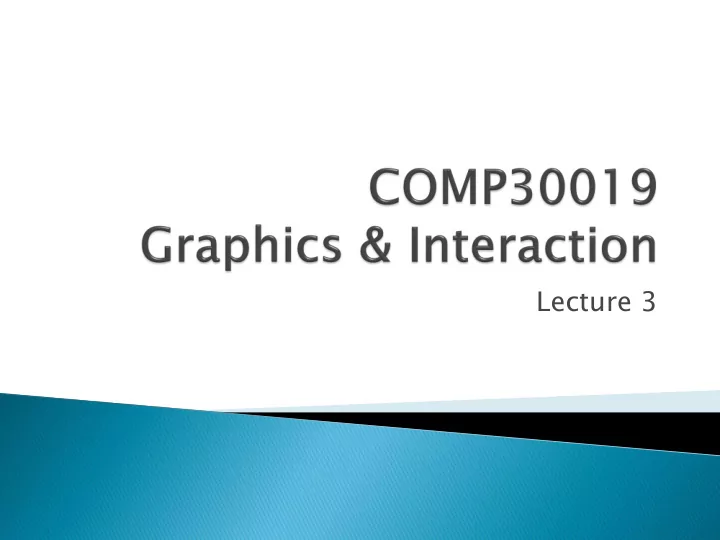

Lecture 3
Game engines, and other graphics programs, generally use either Direct3D (Windows) or OpenGL (most other platforms) Modern PC graphics cards will support some version of both APIs Game engines (like Unity) build upon these APIs to make development easier
Both OpenGL and Direct3D operate a pipeline , consisting of several different stages This allows the programmer to perform a number of different operations on the input data, and provides greater efficiency There are some differences between the OpenGL and Direct3D pipelines Will focus mainly on Direct3D pipeline
Source: Unity
Source: 3dgep.com
For efficiency, the graphics card will render objects as triangles Any polyhedron can be represented by triangles Other 3D shapes can be approximated by triangles
Source: Wikipedia
Reads data from our buffers into a primitive format that can be used by the other stages of the pipeline We mainly use Triangle Lists D3D11 Primitive Types Source: Microsoft
Performs operations on individual vertices received from the Input Assembler stage This will typically include transformations May also include per-vertex lighting
Source: ntu.edu.sg
Source: ntu.edu.sg
Source: ntu.edu.sg
Optional Stages, added with Direct3D 11 These stages allow us to generate additional vertices within the GPU Can take a lower detail model and render in higher detail Can perform level of detail scaling Source: Microsoft
Optional Stage, added with Direct3D 10 Operates on an entire primitive (e.g. triangle) Can perform a number of algorithms, e.g. dynamically calculating normals, particle systems, shadow volume generation Source: Microsoft
Allows us to receive data (vertices or primitives) from the geometry shader or vertex shader and feed back into pipeline for processing by another set of shaders Useful e.g. for particle systems
Interpolates data between vertices to produce per-pixel data Clips primitives into view frustum Performs culling Source: ntu.edu.sg
In order to avoid rendering vertices that will not be displayed in the final image, DirectX performs ‘culling’ Triangles facing away from the camera will be culled and not rendered By default, DirectX performs ‘Counter - Clockwise culling’ Triangles with vertices in a counter- clockwise order are not rendered The order of vertices is therefore important Left hand rule
Produces colour values for each interpolated pixel fragment Per-pixel lighting can be performed Can also produce depth values for depth- buffering
Combines pixel shader output values to produce final image May also perform depth buffering Source: Microsoft
Don’t want to draw objects directly to the screen The screen could update before a new frame has been completely drawn Instead, draw next frame to a buffer and swap buffers when complete.
Source: Oracle
Shader "UnityShaderTutorial/Tutorial1AmbientLight" { Properties { _AmbientLightColor ("Ambient Light Color", Color) = (1,1,1,1) _AmbientLighIntensity("Ambient Light Intensity", Range(0.0, 1.0)) = 1.0 } SubShader { Pass { CGPROGRAM #pragma target 2.0 #pragma vertex vertexShader #pragma fragment fragmentShader fixed4 _AmbientLightColor; float _AmbientLighIntensity; float4 vertexShader(float4 v:POSITION) : SV_POSITION { return mul(UNITY_MATRIX_MVP, v); } fixed4 fragmentShader() : SV_Target { return _AmbientLightColor * _AmbientLighIntensity; } ENDCG } } } Source: digitalerr0r.wordpress.com
Shader ader "UnityShaderTutorial/Tutorial1AmbientLight - The name we can use to identify it Proper perti ties es { _AmbientLightColor ("Ambient Light Color", Color) = (1,1,1,1) _AmbientLighIntensity("Ambient Light Intensity", Range(0.0, 1.0)) = 1.0 } – These can be set in the GUI and accessed in the shader SubSha bShader der – We can have more than one SubShader to operate on different hardware Pass: A subshader can be split into multiple passes, rendering the geometry more than once CGPROGRAM : This is the ‘meat’ of the shader – where we specify code to act at differnet levels of the pipeline. Here we specify a vertex shader and a pixel (fragment) shader. We need at least these two to render the geometry. #pragma gma target t 2.0: 2.0: This specifies the hardware required for the shader to run. 2.0 is the minimal setting, correspond to Shader Model 2.0 (DX9). See the Unity Shader Compilati tion on Target Level els s documentation
#pragma gma vertex ex vertex exShad Shader er #pragma ma fragment ent fragmentSh ntShader ader These specify the names of the functions that will be used as the vertex and fragment shaders respectively float4 4 vertex exShad Shader er(float4 oat4 v:POSI SITION TION) : S SV_PO POSITI SITION { return mul(UNITY_ Y_MA MATR TRIX_MVP IX_MVP, , v); } Converts input vertex from object coordinates to camera coordinates. The SV_POSITION semantic indicates to the rasterizer stage that the output should be interpreted as a position value for the vertex fixed4 ed4 fragmentS entShader hader() : SV_Tar Target get { return _Ambient entLi LightC ghtCol olor or * _AmbientLi entLighIntens ghIntensity ty; } Simply sets the colour of a particular pixel to a specific value. The SV_Target semantic instructs the Output Merger stage interpret this as a color value
The CG/HLSL syntax is quite similar to C, although more restricted. There are a number of permitted datatypes (N.B. Not exhaustive): Source: digitalerr0r.wordpress.com
Source: digitalerr0r.wordpress.com
And a lot of functions Source: digitalerr0r.wordpress.com
Consult the MSDN documentation for a more exhaustive list: Functions: https://msdn.microsoft.com/en- us/library/ff471376.aspx Data Types: https://msdn.microsoft.com/en- us/library/bb509587(v=vs.85).aspx
Recommend
More recommend